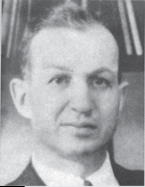Minnesota’s Early Connection and Continued Collaboration With NLC
By Luke Fischer

One hundred years ago, representatives from 10 state municipal leagues gathered at the University of Kansas in Lawrence and set into motion the formation of what would become the National League of Cities (NLC).
According to the NLC website, “The call to found an umbrella organization for state municipal organizations came out of the late 19th century drive to reform and empower local officials, as cities and towns expanded rapidly following the Industrial Revolution. Over the following 100 years, the new organization would also expand both in size and impact, coming to represent nearly 3,000 cities and becoming the top resource and advocate for local governments across America.”

At NLC’s founding in 1924, Minnesota local government values were significantly represented at the table. One of my early predecessors, Morris Lambie, executive secretary of our state league at that time, was in the room that hosted a national conversation and movement that:
- Aimed to build-up city officials.
- Believed in the importance of local decision making.
- Knew the power of bringing people together.
These values and ideals are still relevant today and serve as guideposts to the work we get to do serving the places we call home.
Building-up city officials
As many of you know, local government in Minnesota is collaborative. We stand on a rich tradition of helping our neighbors in their time of need. Today, we need not look further than the unspeakable tragedy in Burnsville where police officers Paul Elmstand and Matthew Ruge and fire paramedic Adam Finseth made the ultimate sacrifice in service to the community.
Neighboring police departments shared services to ensure the community was safe while first responders grieved. Neighboring elected officials stood shoulder to shoulder with the Burnsville Council — lending support. Neighboring staff jumped in to help in a multitude of other ways — many of which will probably never be publicly known. That’s how we all work together.
Local decision making
Our work at the local level is often described as “closest to the customer.” The decisions made in council chambers have a direct impact on community roads, parks, and land use — and city officials are laser focused on the nuance of how these decisions specifically affect their own residents. This past state legislative session brought this value to the forefront as some at the Capitol have sought to preempt local decision making — instead favoring one-size-fits-all mandated solutions.
City officials have banded together to share unique local stories about the special care they bring when solving questions about housing, spending on local projects, and right-sizing solutions to the challenges they face. Just like in 1924, we know today that city officials can and will lead in a way that puts their residents first.
Bringing people together
The cornerstone of local service in Minnesota has always been engagement and input from the residents we serve. City councils have strived to invite the public in and listen carefully to their needs and concerns. Today, as cities wrestle with public engagement, councils seek new and creative ways to get feedback and bring people along with needed change.
Cities are taking steps to better understand the needs of new residents as well, by engaging emerging faith communities, hosting virtual town halls, and holding on-site public meetings at proposed project locations. At the core, elected and appointed folks here have always believed that more engagement and more listening results in better solutions.
Special relevance today
In 1924, could the NLC founders have imagined that cities across the country would someday come together to form a new federal-city partnership that stemmed from a global pandemic? Would they have expected cities to band together to push back attempts by state legislatures to erode local control? Did they anticipate questions about virtual town halls and resident feedback on social media?
Reflectively, it’s no surprise to think that there was someone from Minnesota in Lawrence representing the values and ideals that our local officials have led with for well over a century. I like to think that Morris Lambie made the trek to Kansas to ensure our National League could benefit from the Minnesota experience — and that we could look for ways to ensure our traditions of building up and supporting local government, our core value of local decision making, and the recognition that strength comes from bringing people together should be part of the national model.
Luke Fischer is executive director of the League of Minnesota Cities. Contact: lfischer@lmc.org or (651) 281-1279.

